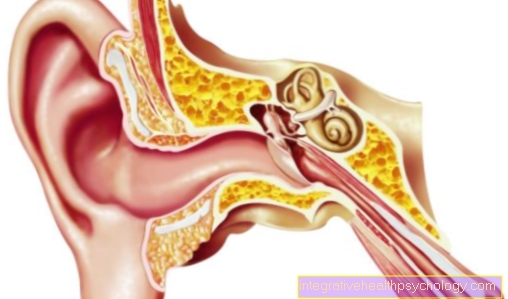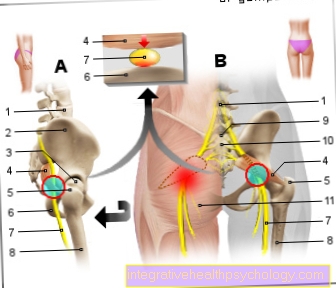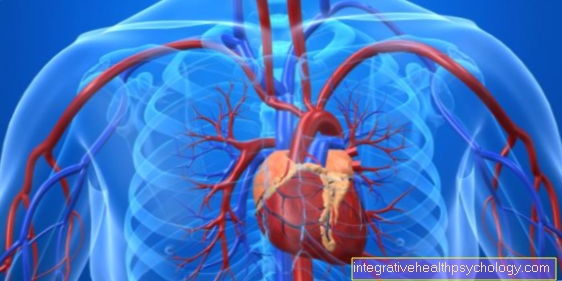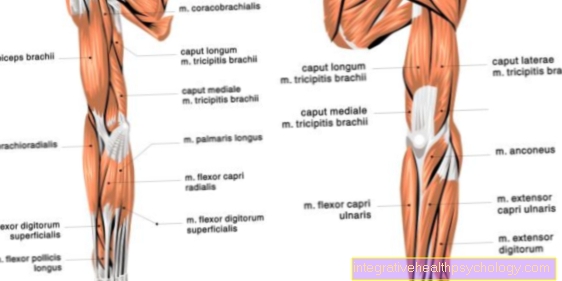Cachexia
definition
Cachexia is the name for weight loss that is usually caused by a disease. In the course of a serious illness, extreme physical stress depletes all reserves. This also includes the fatty tissue that protects the various organs and the muscles.
As a result, those affected look extremely emaciated and weakened. Cachexia is a typical condition that is often seen in people with advanced cancer.

causes
Cachexia is a phenomenon that is usually triggered by a so-called systemic disease. This means that it is a disease that affects the entire body and is a great physical strain. A typical cause of cachexia is therefore a wide variety of cancers.
But even a serious infectious disease, such as AIDS, can lead to cachexia in an advanced stage. Chronic heart or kidney failure can also cause cachexia. This is because the limited functionality of these important organs makes most processes in the body more difficult.
As a result, the body tries to use all possible sources of energy, including the fat around the organs.
But other causes, such as deprivation of food, are also possible. This can occur, for example, during a hunger strike or anorexia. Metabolic disorders, alcohol addiction, or mercury poisoning can also cause cachexia in rare cases.
cancer
One of the most common causes of cachexia is cancer. This is also referred to as the so-called tumor cachexia. The cancer leads to an increase in certain cycles, such as an increased activation of the immune system.
Furthermore, the disease represents an extreme stressful situation for the body. These are the triggers for increased energy consumption, which in turn is reflected in the depletion of all of the body's reserves. In addition, the body is weakened by radiation and / or chemotherapy.
You can find more information about radiation therapy at: Treatment by radiation therapy
Malnutrition
Malnutrition can also lead to cachexia. Malnutrition can arise from a variety of causes. These include various diseases, eating disorders or malnutrition with the reduced intake of important energy substances.
Over time, malnutrition leads to loss of appetite, which further exacerbates symptoms. There is severe weight loss and the body begins to use up whatever energy reserves it has. This can ultimately lead to the clinical picture of cachexia.
I recognize cachexia by these symptoms
Cachexia is massive weight loss that is accompanied by relatively characteristic symptoms. According to the definition, cachexia is when more than 5 percent of the current body weight is lost within half a year. This gives rise to a typical appearance of severe emaciation. This makes the different bones of the affected person very visible.
Any fat reserves disappear and make the ribs, for example, more visible. The face also appears sunken and hollow, as the cheekbones are clearly visible. The loss of fat reserves can even be seen in the eyes, which are deeper. This is because there is a pad of fat behind the eyeballs, which is also used up over time with cachexia.
Depending on the cause of the cachexia, there may be additional symptoms. These include, for example, increased bleeding of the skin and gums (see also: Bleeding gums), brittle nails and hair and the increased incidence of inflammation, especially around the mouth. Visual disturbances and sensory disturbances due to damage to the nerves can also occur.
This is what terminal cachexia looks likeThe end stage of cachexia is characterized by extreme emaciation and emaciation of the body. In the course of cachexia, the body uses up the last possible energy reserves of the body, so that in the end stage of cachexia the muscles of the body have largely disappeared.
The body's fatty tissue is also completely used up. The body is extremely weak and those affected can usually no longer stand. Movements are hardly possible any more because they cost too much energy.
diagnosis
The diagnosis of cachexia is made by a doctor. The main focus is on the appearance of the person concerned. Various factors, such as posture, skin color, and the protruding bone structures, can provide clues for the diagnosis.
Another important criterion is the person's weight and height. If the body mass index (BMI) calculated from this is less than 18.5 kg / m², it is defined as cachexia. Furthermore, the anamnesis, i.e. the doctor-patient discussion, is very important in the diagnosis in order to find out possible causes for the cachexia.
treatment
Treatment of cachexia is often relatively complex. First and foremost, the cause of the cachexia must be learned in order to adequately treat it. If this is still treatable, the cachexia will regress over time.
Correspondingly, for example in the case of cachexia caused by heart failure, drugs are given that reduce the disturbances in the heart function. It is also treated for kidney failure and many other diseases. There are different treatment options available for cancer, depending on the type of cancer. This includes radiation and the use of various chemotherapies.
If the person concerned suffers from AIDS, the drug Serostim can be used for treatment. If the cachexia is caused by an eating disorder or malnutrition, therapy consists of a change in diet, which is usually accompanied by psychotherapy.
Unfortunately, the causes of cachexia cannot always be treated. Accordingly, it is often necessary to carry out palliative, i.e. non-curative, measures. This includes, for example, the artificial feeding of the person concerned.
Artificial nutrition
If a cachexia cannot be improved quickly enough by combating the cause, artificial nutrition is necessary in many cases. Given the cause of the cachexia, nutrients are often given by infusion into the veins. This method is also known as parenteral nutrition because the digestive tract is not involved in the form of nutrition.
In some cases, so-called enteral artificial feeding with the help of a gastric tube can also be considered.
Life expectancy
The life expectancy of cachexia depends on whether the underlying cause or disease is curable or not. As such, cachexia cannot be cured and can only be improved accordingly by treating the cause.
Unfortunately, many affected people have incurable diseases, such as cancer. Accordingly, life expectancy is often not very high. Conversely, the diagnosis of cachexia does not mean that life expectancy is very low. Therefore, no general statement can be made about life expectancy in the presence of cachexia.


















.jpg)





.jpg)




